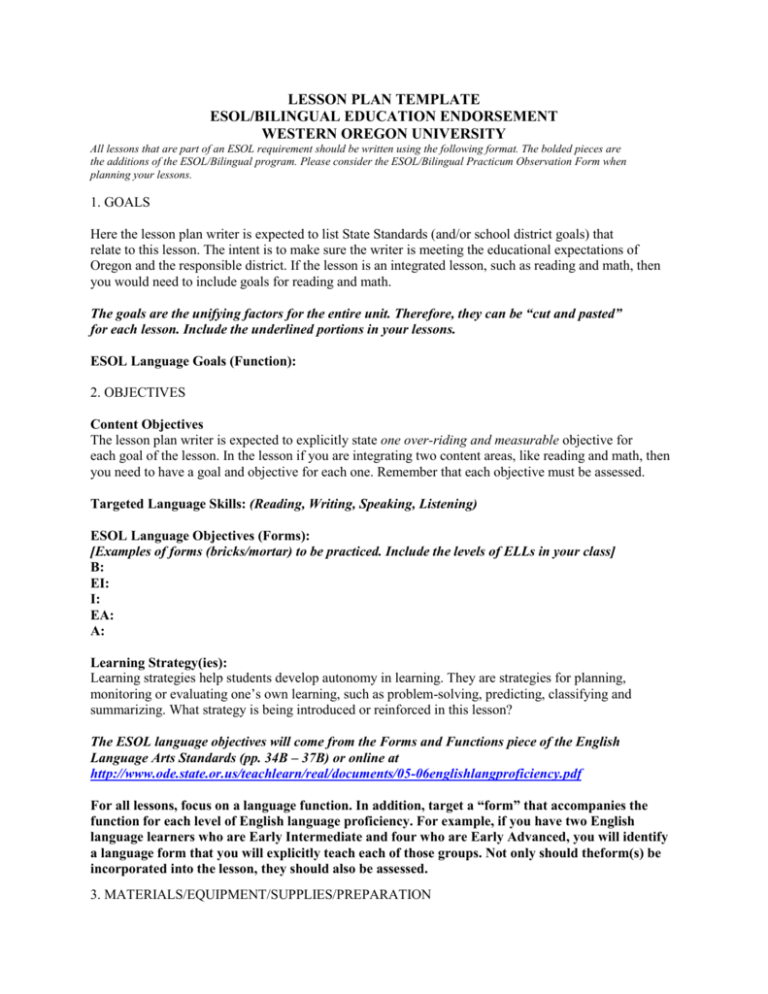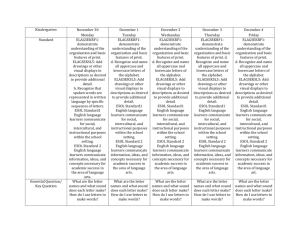File - Lesson Planning
advertisement

LESSON PLAN TEMPLATE ESOL/BILINGUAL EDUCATION ENDORSEMENT WESTERN OREGON UNIVERSITY All lessons that are part of an ESOL requirement should be written using the following format. The bolded pieces are the additions of the ESOL/Bilingual program. Please consider the ESOL/Bilingual Practicum Observation Form when planning your lessons. 1. GOALS Here the lesson plan writer is expected to list State Standards (and/or school district goals) that relate to this lesson. The intent is to make sure the writer is meeting the educational expectations of Oregon and the responsible district. If the lesson is an integrated lesson, such as reading and math, then you would need to include goals for reading and math. The goals are the unifying factors for the entire unit. Therefore, they can be “cut and pasted” for each lesson. Include the underlined portions in your lessons. ESOL Language Goals (Function): 2. OBJECTIVES Content Objectives The lesson plan writer is expected to explicitly state one over-riding and measurable objective for each goal of the lesson. In the lesson if you are integrating two content areas, like reading and math, then you need to have a goal and objective for each one. Remember that each objective must be assessed. Targeted Language Skills: (Reading, Writing, Speaking, Listening) ESOL Language Objectives (Forms): [Examples of forms (bricks/mortar) to be practiced. Include the levels of ELLs in your class] B: EI: I: EA: A: Learning Strategy(ies): Learning strategies help students develop autonomy in learning. They are strategies for planning, monitoring or evaluating one’s own learning, such as problem-solving, predicting, classifying and summarizing. What strategy is being introduced or reinforced in this lesson? The ESOL language objectives will come from the Forms and Functions piece of the English Language Arts Standards (pp. 34B – 37B) or online at http://www.ode.state.or.us/teachlearn/real/documents/05-06englishlangproficiency.pdf For all lessons, focus on a language function. In addition, target a “form” that accompanies the function for each level of English language proficiency. For example, if you have two English language learners who are Early Intermediate and four who are Early Advanced, you will identify a language form that you will explicitly teach each of those groups. Not only should theform(s) be incorporated into the lesson, they should also be assessed. 3. MATERIALS/EQUIPMENT/SUPPLIES/PREPARATION List all of the materials, equipment and supplies needed to carry out this lesson. Include notes about where special supplies can be found and if materials need to be prepared ahead of time. Think about the needs of English language learners when choosing/designing your materials. 4. PROCEDURE The procedure has several parts as indicated below and shows the sequence the teacher will follow in helping the students meet the stated objective. Next to each part of the procedure indicate your estimate of the length of time required. A. Anticipatory set, motivation or hook This is a brief activity to "hook" the learners on the topic of the lesson. It can include reference to a previous lesson, reading of a short story, a demonstration, telling the class what the objective is, showing an example to stimulate interest, etc. This is a good time to use visuals and realia. B. Teaching/Modeling This is where the lesson plan writer gives the step-by-step procedure for teaching the class what is necessary to meet the stated objectives. This is where one lists what the teacher does, including questions the teacher plans on posing to the group. This is where one lists what background information will be given, what instruction will be given and, in general, how the teacher is going to help the class learn what is necessary to meet the objective. This is a critical part of the lesson and should demonstrate careful thought. Be sure to explicitly model and teach the language forms you want the students to practice. C. Group Application/Guided Practice This is an extremely important piece for English language learners. [If you do not use this section, make sure your teaching/modeling piece is very interactive or that you are using cooperative learning.] It is where one lists the activities the class will do under the teacher's guidance. Its purpose is to allow the class to try out what has been learned before proceeding on their own, and to provide ample opportunity for the teacher to correct misinformation or flawed application of a concept, skill, or strategy. Include how the teacher will check to make sure the students are learning what is expected (checking for understanding/comprehension). If the students proceed to the next step and are confused about the directions/content, they will “practice incorrectly.” As Madaline Hunter warned, “Practice makes permanent,” and reteaching is much more time-consuming than teaching/learning it correctly in the first place! This section is also a prime opportunity for students to be active in terms of their four language skills (reading, writing, speaking, and listening). D. Independent Application/Independent Practice It is where one lists what students will do independently or in small groups to demonstrate learning by applying what was learned. It usually is the behavior or performance listed in the objective. At some point students should be held accountable individually for demonstrating their mastery of the learning objectives. Otherwise, you won’t be able to ensure that the students have learned the material through formal or informal assessments. Moreover, you wouldn’t have the opportunity to re-teach or clarify any confusion. If the independent practice is sent home, make sure that students understand the directions and can complete that work on their own. E. Closure/Expansion This is a way of ending the lesson and preparing for what is coming next. It can be a summary of what was learned in the lesson and instructions for transition. It could also be a discussion of the skills or strategies that were used or an opportunity for students to verbalize their reflections about the learning process. It could also be an opportunity for students to self-assess. 5. MEETING VARYING NEEDS/DIFFERENTIATION This is where the lesson plan writer states additional considerations for children, including English language learners and those with special needs or abilities. Think about the physically challenged, linguistically and culturally diverse students, the developmentally delayed and the gifted and talented and discuss what might be done to meet their needs. Think about the learning styles of your students and the struggling readers/writers/mathematicians, etc. Strategies that will benefit English language learners should be easily evidenced throughout the lesson plan, and ideally during each phase of the “Procedure.” The lesson plan writer should underline or highlight sheltered strategies or other activities/parts that were specially designed to improve the comprehension of multilingual students. They should reflect the lesson instead of being generic for each lesson. Make sure you have addressed the specific language needs of the English language learners in your class. 6. ASSESSMENT The assessment consists of checking to see that most or all of the students can do what was stated in the content and language objectives at the beginning of the lesson plan. State how and when formal and informal assessments will occur. This is very important. How will you know what skills/knowledge each student has mastered? If a student has not reached the objective(s), when and how will you provide more opportunity for practice and/or reteaching. In addition, think about the language needs of English language learners. Is a student’s English language proficiency level being assessed instead of their knowledge of the content/skill? What kind of testing accommodations can be made so that the assessment can guide your instruction of content and language? 7. REFLECTION This is completed after having taught the lesson. It is an opportunity to discuss the positives and negatives of the lesson. An important part of the reflection is considering ideas for improving the lesson design and/or the delivery. We should strive to not make the same mistake twice! Statements made about how well a lesson went or how well a lesson did not go should be supported by an explanation. Think specifically about groups of students, including your English language learners. One sample format is: 1. How did you feel about the lesson? How did it go overall? 2. What went well? 3. What happened that you wish had gone differently? Why did it happen? 4. What will you modify for future lessons? 5. Other comments











